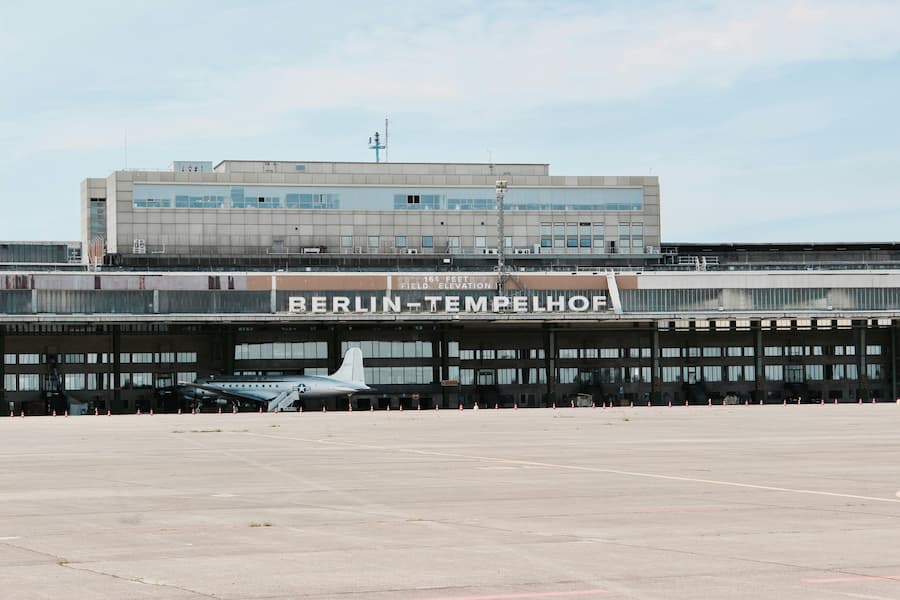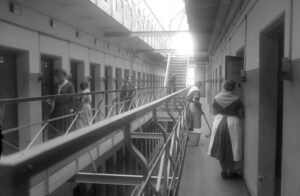Several years ago, I lined up my bike on the edge of one of Tempelhof’s airport’s runways, and rather embarrassingly for a middle-aged man, imagined myself firewalling the throttles of an old airplane. Like a child at play, I peddled furiously, not quite achieving take-off speed, and could barely imagine all the momentous events that took place on this tarmac I was speeding down. Berlin – where else can you play like a kid while history echoes around your mind?

When Berliners stroll through the sprawling green space of Tempelhof Field today, they’re walking (or riding!) on one of the most remarkable sites in aviation history. This massive former airport, with its imposing 1.2-kilometer-long terminal building curving like a steel and stone crescent, tells the story of Berlin’s darkest and finest hours. But perhaps its finest moment came in 1948, when this Nazi-era colossus transformed into the heart of one of Europe’s greatest humanitarian operations: the Berlin Airlift.
Nazi Tempelhof
Tempelhof’s story begins in the 1920s, but it was under the Nazi regime that it took its recognizable, modern form. In 1934, Hitler’s architect Ernst Sagebiel designed the enormous terminal building that still stands today – a masterpiece of authoritarian architecture intended to awe visitors with its sheer, all-embracing scale. The limestone-clad building, with its distinctive curved shape, adorned with eagles grasping swastikas, was one of the largest structures in Europe at the time.
The terminal building was part of Hitler’s plans for «Germania,» Hitler’s megalomaniacal vision of a rebuilt Berlin as the capital of his thousand-year Reich. Tempelhof was designed to serve as the gateway to this imagined capital, with its impossible scale matching the outsized ambitions of the Nazi regime. The terminal was meant to awe visitors arriving in what Hitler planned as the world’s most impressive city – a city that, thankfully, was never built.
As the Third Reich crumbled in 1945, Tempelhof became one of the last major defensive positions in central Berlin. The Soviet 5th Shock Army and elements of the 8th Guards Army approached the airport from the south and east in late April. The airport was an important goal, as it represented, to the Soviet planners, the last really viable escape route from the capital for the enemy leadership.
A hodgepodge of airport staff, Wehrmacht and SS units defended the complex fiercely for around half a day. The fighting was particularly intense around the terminal building and the northern edge of the airfield, involving tanks, flak units as well as infantry. By April 28th 1945 the Soviet forces had largely secured the airport after bitter house-to-house fighting in the surrounding neighborhoods of Neukölln and Kreuzberg.
The capture of Tempelhof was strategically important for the Soviet advance into central Berlin, as it opened up a clear approach to the government district just a few kilometers away, while denying the German leadership its final escape and supply route. When Soviet troops finally secured the terminal building, they found a structure damaged by combat but still largely intact – a testament to its robust construction. Shortly afterward, they photographed the red flag fluttering triumphantly over the Nazi eagles. The airport turned out to be a gateway to the city, but not the one Hitler had intended.
On July 4, 1945, the airport was turned over to the newly arrived Americans, as it fell within their sector of a now divided Berlin. This would soon prove to be key to the future West Berlin’s survival.
The Cold War and the Berlin Airlift
Irony would dominate Tempelhof just three years later: the massive terminal building that had been designed to welcome visitors to Hitler’s Germania would instead become a crucial lifeline for democracy during the Berlin Airlift. The airport – with its vast size, its sturdy construction, its vast aprons – would prove perfect for its new role as the hub of the Western Allies’ determination to preserve free Berlin.
The Berlin Blockade began in June 1948, when the Soviet Union cut off all land access to West Berlin, hoping to force the Western Allies out of the city. The Soviets believed it would be impossible to supply two million people by air alone. They were wrong. Operation Vittles, as the Americans named it (the British called it Operation Plainfare), would prove to be one of the most remarkable feats of logistics in history.
Tempelhof became the main hub of the operation. During the airlift’s peak, planes landed at Tempelhof every three minutes – a precision ballet of aircraft that pilots called the «Easter Parade.» These planes, primarily C-47 Skytrains and C-54 Skymasters, brought everything from coal and food to medicine and candy.
One of the airlift’s most beloved figures was Gail Halvorsen, known as the «Candy Bomber» or «Uncle Wiggly Wings.» After meeting a group of children at Tempelhof’s fence, Halvorsen began dropping small parachutes made from handkerchiefs, carrying chocolate and gum to Berlin’s children. His individual initiative grew into Operation Little Vittles, which eventually dropped 23 tons of candy over Berlin. Halvorsen’s simple act of kindness became a powerful symbol of American goodwill and helped transform Tempelhof from a symbol of oppression to one of hope.
The numbers from the airlift are staggering: over 277,000 flights delivered more than 2.3 million tons of supplies to Berlin. At its peak, more tonnage was arriving by air than had previously been transported by rail before the blockade. The Soviets finally admitted defeat and lifted the blockade in May 1949, though the airlift continued for several months to build up reserves.
After the airlift, Tempelhof continued as a civilian airport, serving as West Berlin’s main gateway to the free world during the Cold War. Its unique architecture, with its massive canopy allowing passengers to walk directly from the terminal to their aircraft protected from the weather, made it a favorite among travelers. The terminal building housed not just airport operations but also the U.S. Air Force, which maintained a presence there until the fall of the Berlin Wall.
Today’s Tempelhof
In 2008, despite protests from many Berliners, Tempelhof closed its doors to air traffic. But the story didn’t end there as the massive space was transformed into a public park. Today, where cargo planes once landed bringing life-saving supplies, Berliners fly kites, ride bicycles, and tend community gardens. The massive terminal building, protected as a historical monument, hosts events and houses various cultural institutions. It even served to house refugees in recent years, underlining its role as a place of refuge, as a place of arrival and new beginnings.
As a visitor, I encourage you to make the trip down to the former airport. It’s easily reachable by U-Bahn (Platz der Luftbrücke), and you can easily identify the unique memorial to the Berlin Airlift outside the old main entrance to the terminal. If you’re a photographer, get here at sunrise for some great photo ops.
So, if you’re in search of remnants of the Reich, Tempelhof is a key site. If it’s Cold War history you’re after, this is a must-see. If you’re interested in urban renewal and modern city planning and reuse of space, this is a place for you. If you want to rent a bike and pretend to be an airplane, yep, this is where you have to go. In short, Tempelhof has something for everybody. And, in a common Berlin motif, it’s always a good place to reflect on the twists and turns of history.




